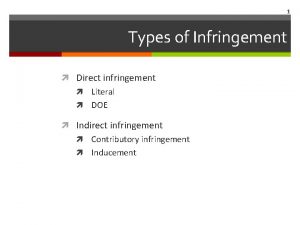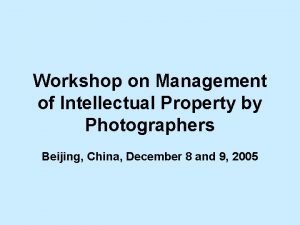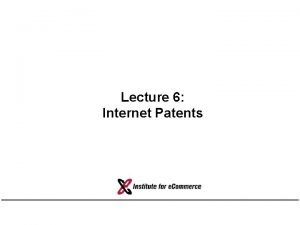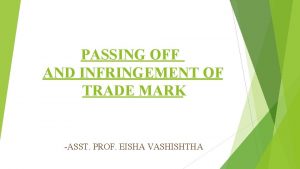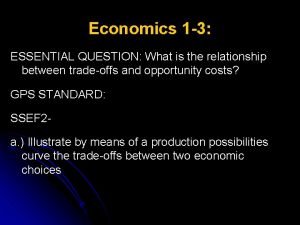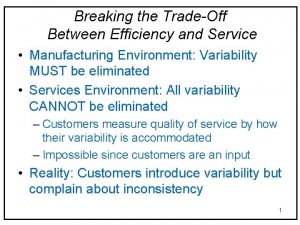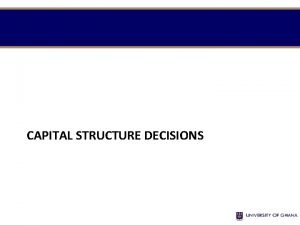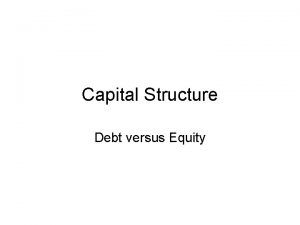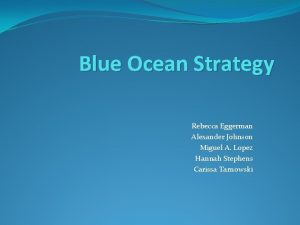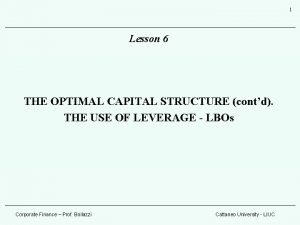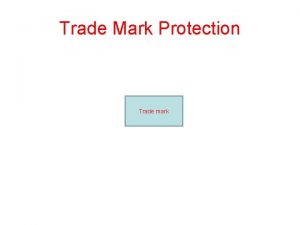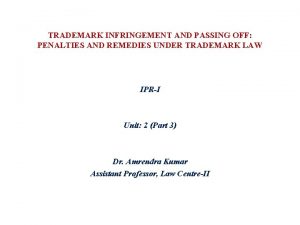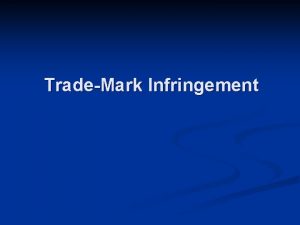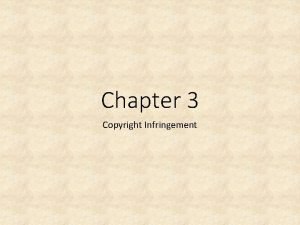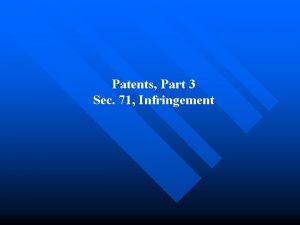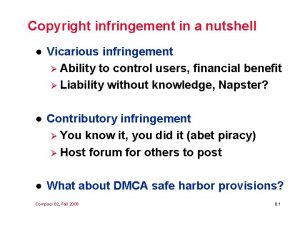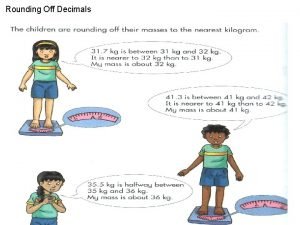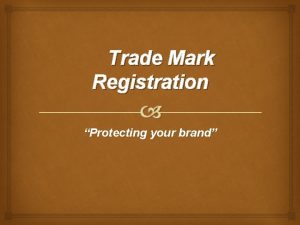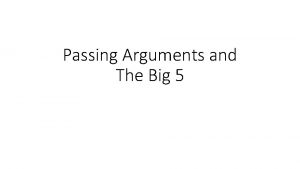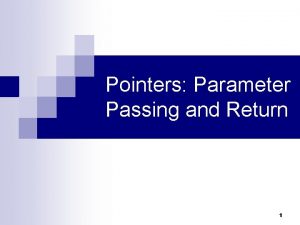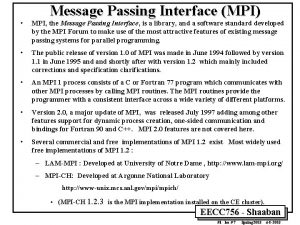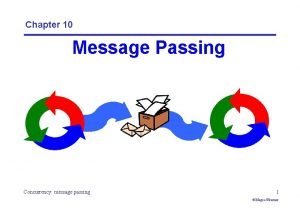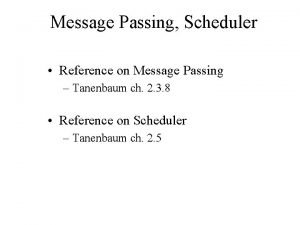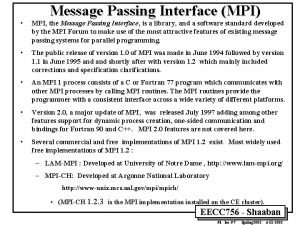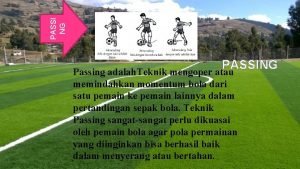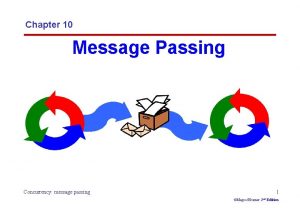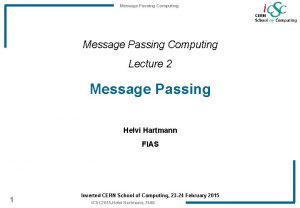PASSING OFF AND INFRINGEMENT OF TRADE MARK ASST























- Slides: 23

PASSING OFF AND INFRINGEMENT OF TRADE MARK -ASST. PROF. EISHA VASHISHTHA

TRADEMARK A Trade mark may be defined as a lawfully protected abstract, word, symbol, color, mark, slogan or a mixture of those related to an organization or a selected product that differentiates it from the others accessible within the market. The essence of a trademark is that, it can be uniquely identified by a purchaser in the market. A trademark carries many attributes, most important being the goodwill it has earned over a period of time.

TRADEMARK ACT, 1999 Sec 2 (zb) The act defines Trademark as: “Trade mark" means a mark capable of being represented graphically and which is capable of distinguishing the goods or services of one person from those of others and may include shape of goods, their packaging and combination of colors; and (i) in relation to Chapter XII (other than section 107), a registered trade mark or a mark used in relation to goods or services for the purpose of indicating or so as to indicate a connection in the course of trade between the goods or services, as the case may be, and some person having the right as proprietor to use the mark and (ii) in relation to other provisions of this Act, a mark used or proposed to be used in relation to goods or services for the purpose of indicating or so to indicate a connection in the course of trade between the goods or services, as the case may be, and some person having the right, either as proprietor or by way of permitted user, to use the mark whether with or without any indication of the identity of that person, and includes a certification trade mark or collective mark

TRADEMARK IN BRIEF A mark capable of being represented graphically Capable of distinguishing the goods or services May include shape of goods, their packaging and combination of colors A registered trade mark /mark/ proposed trademark used to indicate a connection in the course of trade between the goods or services Includes a certification trade mark or collective mark

POPULAR TRADEMARKS

INFRINGEMENT OF TRADEMARK Section 29 of the Trade mark Act, 1999 WHEN A MARK IS INFRINGED If the mark in dispute is identical with or deceptively similar to the registered trademark and is in relation to the same or similar goods or services; If the identical or similar mark can cause confusion in the minds of general public to have an association with the registered trademark If the registered trademark is used as a part of trade name or business concern for goods and services in respect of which the trademark is registered If the trademark is advertised and as a result it takes unfair advantage or is contrary to the honest practices or is detrimental to the distinctive character and reputation of the registered trademark. If the registered trademark is used in the material meant for packaging or labelling of other goods or as a business paper without due authorization of the registered user.

FALSIFICATION OF TRADEMARK Sec. 103 Falsification of trademark is said to be done when a person does following acts: If any trademark has been falsely applied to goods and services Makes, possesses or disposes of any instrument with the object and purpose of falsifying a trademark Falsely indicates name of the country or place where the goods have been made or the name or address of the person who is responsible for its manufacturing Alters or tampers with the indication of origin that is applied or required to be applied to a product

ACTS THAT DO NOT CONSTITUTE INFRINGEMENT-Sec 30 When any person makes use of a trademark in accordance with honest practices in industrial or commercial matters When such use is not in pursuit of taking undue advantage or proves to be detrimental to the distinctive character or repute of the trademark. Use of a mark for the indication- Whenever any trademark is used in order to indicate the kind, quality, quantity, intended purpose, value, geographical origin, the time of production of goods or of rendering of services or any other characteristics of goods or services. Use of mark which is outside the scope of registration- When trademarks are registered, there are certain cases where they are subjected to certain conditions and limitations. Whenever the alleged infringement is under the ambit of those limitations, then it does not constitute to be a case of infringement of trademarks. Implied consent – Whenever the infringed use of a trademark is in the continuance of the permitted use by the original proprietor who has subsequently not removed or obliterated it, in such cases the use cannot be said to be an infringement. Use of trademark in relation to parts and accessories Use of trademarks identical or similar to each other

PASSING OFF Passing off is not defined in the act. Passing off is a common law tort, which can be used to enforce unregistered trademark rights. Indirect references can be found in in section 27 (2), 134 (1) (c) and Section 135 of Trademarks Act. Section 134 (1) (c) refers to jurisdiction/power of District courts to try the suit and even issue injunction in matter pertaining to Passing off suits. It can be defined as: A misrepresentation made by a trader in the course of trade to prospective customers of his or ultimate consumers of goods or services supplied by him, which is calculated to injure the business or goodwill of another trader (in the sense that this is a reasonably foreseeable consequence) and which causes actual damage to a business or goodwill of the trader by whom the action is brought or will probably do so. "

PASSING OFF Contd. Passing off can also be: extended passing off – where a misrepresentation as to the particular quality of a product or service causes harm to another's goodwill reverse passing off - where a trader markets another business' goods or services as being his own Law of passing off comes into application when the following elements are present: 1. Goodwill 2. Deceptive similarity in the products in question. 3. Losses/ damages due to such action of passing off.

ELEMENTS OF PASSING OFF GOODWILL The action of passing off lies where there is a real possibility of damage of goodwill to business. Therefore, the plaintiff has to establish a goodwill in his business or his goods or services with which the trade or public will be led to associate the defendant’s activities. Goodwill need not be established in the mind of every member of the relevant public, but in a significant section of it. DECEPTIVE SIMILARITY Two marks, when placed side by side, may exhibit many and various differences, yet the main idea left on the mind by both may be the same. A person acquainted with one mark, and not having the two side by side for comparison, might well be deceived, if the goods were allowed to be impressed with the second mark, into a belief that he was dealing with goods which bore the same mark as that which he was acquainted. LOSS/INJURY The party claiming benefit under passing off must have incured loss due to other party’s action of passing off their goods / services as of the goods / services of the first party.

ACTION OF PASSING OFF In the case of Durga Dutt vs. Navaratna Pharmaceutical , Supreme Court is set out the distinction between infringement and passing off. The Trademark provides protection to registered goods and services and a passing off action provides protection to unregistered goods and services. The remedy is same in both the cases. The use by the defendant of the trade mark of the plaintiff is not essential in an action for passing off, but in the case of an action for infringement this will not applicable. The third important distinction between these two is that if the essential features of the trade mark of the plaintiff have been adopted by the defendant, the fact that the get up, packing and other writing or marks on the goods or on the packets in which he offers his goods for sale marked differences or indicate clearly a trade origin different from that of the registered owner of the mark would be immaterial; but in case of passing off the defendant may escape liability if he can show that the added matter is sufficiently to distinguish his goods from those of the plaintiff.

PASSING OFF-EXAMPLES

INFRINGEMENT & PASSING OFF S. No. Infringement Passing off 1. Type of remedy The statutory remedy under Section 29(1) of Common-Law remedy the Trade mark Act, 1999 2. 3. Registration Proof It is a pre-requisite Plaintiff is only required to show deceptive similarity, as there is a presumption of confusion 4. Jurisdiction The registered proprietor or registered user of Section 20 of the Civil Procedure Code, 1908 the trade mark can institute the suit where would apply they actually and voluntarily reside or carries his business or personally work for gain It is not required Apart from proving deceptive similarity, the Plaintiff is also required to prove confusion in public and the likelihood of injury to the plaintiff's goodwill

Cadbury India Limited and Ors. V. Neeraj Food Products An action for trade mark infringement is a statutory remedy and on the other hand, an action for passing off is a common law remedy. The use of the trade mark of the plaintiff, by the defendant, is also a prerequisite in the case of an action for infringement while it is not a necessity of an action for passing off. In an action for infringement of the plaintiff's trade mark, it is immaterial that the outfit, outer covering and other written marks on the goods originate from a different source than that of a registered proprietor's trade mark. The liability of the defendant in such a case may be absolute. However, in case of passing off of trade mark, the defendant may escape liability if he can show that the material added by him is sufficient to distinguish his goods from that of the plaintiff's goods. In an action for infringement, the Plaintiff on account of it being a registered trade mark in dispute claims to have an exclusive right to use the mark concerning those goods. However, a passing off by a person of his goods as those of another, in essence, is an action of deceit.

S. Syed Mohideen v. P. Sulochana. Bai Passing off right is a wider remedy than that of infringement. Passing off doctrine operates on the general principle that no person is entitled to represent his or her business as the business of another person. The action of deceit is maintainable for diverse reasons other than that of registered rights which are allocated rights under the Act.

CADILA HEALTH CARE LTD. Vs CADILA PHARMACEUTICALS Apex court observed that : Public interest would support lesser degree of proof showing confusing similarity in the case of trade mark in respect of medicinal product as against other non-medicinal products. Drugs are poisons, not sweets. Confusion between medicinal products may, therefore be life threatening, not merely inconvenient. Broadly stated, in an action for passing off on the basis of unregistered trade mark generally for deciding the question of deceptive similarity the following factors to be considered: The nature of the marks i. e whether the marks are word marks or label marks or composite marks i. e. both words and label marks. The degree of resemblances between the marks, phonetically similar and hence similar in idea. The nature of goods in respect of which they are used as trade mark. The similarity in the nature, character and performance of the goods of rival traders. The class of the purchasers who are likely to buy the goods bearing the marks they require, or their education or intelligence and a degree of care they are likely to exercise in purchasing goods.

Starbucks Corporation v. Sardarbuksh Coffee & Co. & Ors.

CASE FACTS Starbucks registered their trademark which consisted of a word mark i. e. STARBUCKS and a logo depicting “crowned maiden with long hair” in India in 2001. The defendants began their business in 2015 by calling their enterprise "Sardarbuksh Coffee & Co" where "Sardar" is a Hindi word meaning "Commander" and "Buksh" is a Hindi word meaning "Pardon. " In May 2018, the defendants formed a private limited company with the name "Sardar Buksh Private Limited" and have been operating under that name since. The goods and services rendered by both the plaintiff and the defendant are the same. The defendants used a logo consisting of a circular black band with the words 'SARDARBUKSH COFFEE & CO. ' and a turban Commander along with wavy lines extending from the edges. In 2017, Starbucks asked the defendants to change their logo by way of a letter of demand. Further, it was modified to a color scheme of black and yellow and operations were commenced with the newly modified logo.

CASE FACTS contd. New modified logo: Starbucks later filed a suit against Sardarbuksh in the Delhi High Court. The legal perspective was the deceptively similar analogy which is derived from Section 2(1)(h) read in Section 11 of the Trademarks Act, 1999 which states that, when two marks are put next to each other, if they cause confusion or mislead the viewers, they would be deceptively similar and therefore cannot be registered.

COURT’s ORDER Courts relied on the following cases to weigh the deceptively similar analogy, such as test of likelihood and confusion, goodwill etc. 1. National Sewing Thread Co. Ltd. vs. James Chadwick and Bros 2. M/s Nandhini Delux v. M/s Karnataka Co-operative Milk Producers Federation Ltd Courts held: 1. The fact that both the parties are dealing in same kind of trade and offering same services to its customers, plays an important role. 2. The marks being deceptively similar would also have certain economic complications on the plaintiff. Starbucks is a global brand having goodwill that has been amassed over a long period of time 3. It can be said that the defendant had the knowledge of the global reputation that Starbucks has and further wanted to exploit that image to get market attention rapidly. Court ordered the defendants to modify their store name from “Sardarbuksh Coffee & Co. ” to “Sardarji-Bakhsh Coffee & Co. ”. The order for modification was given to the 20 stores that have not yet opened. The court also permitted to use the name “Sardarbuksh Coffee & Co. ” for the previously operating two stores. On 27 th September 2018, it was also agreed that the defendant would change the name of all its outlets to "Sardarji-Bakhsh Coffee & Co. " In addition, it was explained and decided that, if a third party uses the term "Bakhsh", then the defendant would have the right to bring an action against such a violator. The suit was settled on those terms.

IMPORTANT CASE LAWS Reckitt & Colman of India Ltd. vs. M. P. Ramachandran & Anr Rupa & Co. Ltd v. Dawn Mills Co. Ltd Honda Motors Co. Ltd V Charanjit Singh & Others John Roberts Powers School v Tessensohn

THE END
 Literal infringement
Literal infringement Nancy kwai
Nancy kwai Intellectual property rights in professional practices
Intellectual property rights in professional practices Infringement of patent
Infringement of patent Starbucks vs sardarbuksh
Starbucks vs sardarbuksh Trade off definition economics
Trade off definition economics Trade offs and opportunity cost
Trade offs and opportunity cost Scarcity def
Scarcity def Trade off and opportunity cost
Trade off and opportunity cost Breaking the trade-off between efficiency and service
Breaking the trade-off between efficiency and service Trade diversion and trade creation
Trade diversion and trade creation Umich
Umich Which is the most enduring free trade area in the world?
Which is the most enduring free trade area in the world? Trade diversion and trade creation
Trade diversion and trade creation Liner trade and tramp trade
Liner trade and tramp trade Elbows off the table fingers off the food song
Elbows off the table fingers off the food song Force distance trade off
Force distance trade off Trade-off vs opportunity cost
Trade-off vs opportunity cost Opportunity cost vs trade off
Opportunity cost vs trade off Trade-off economics example
Trade-off economics example Agency cost
Agency cost Advantages of debt
Advantages of debt Strategic trade off
Strategic trade off Trade off theory of capital structure
Trade off theory of capital structure
